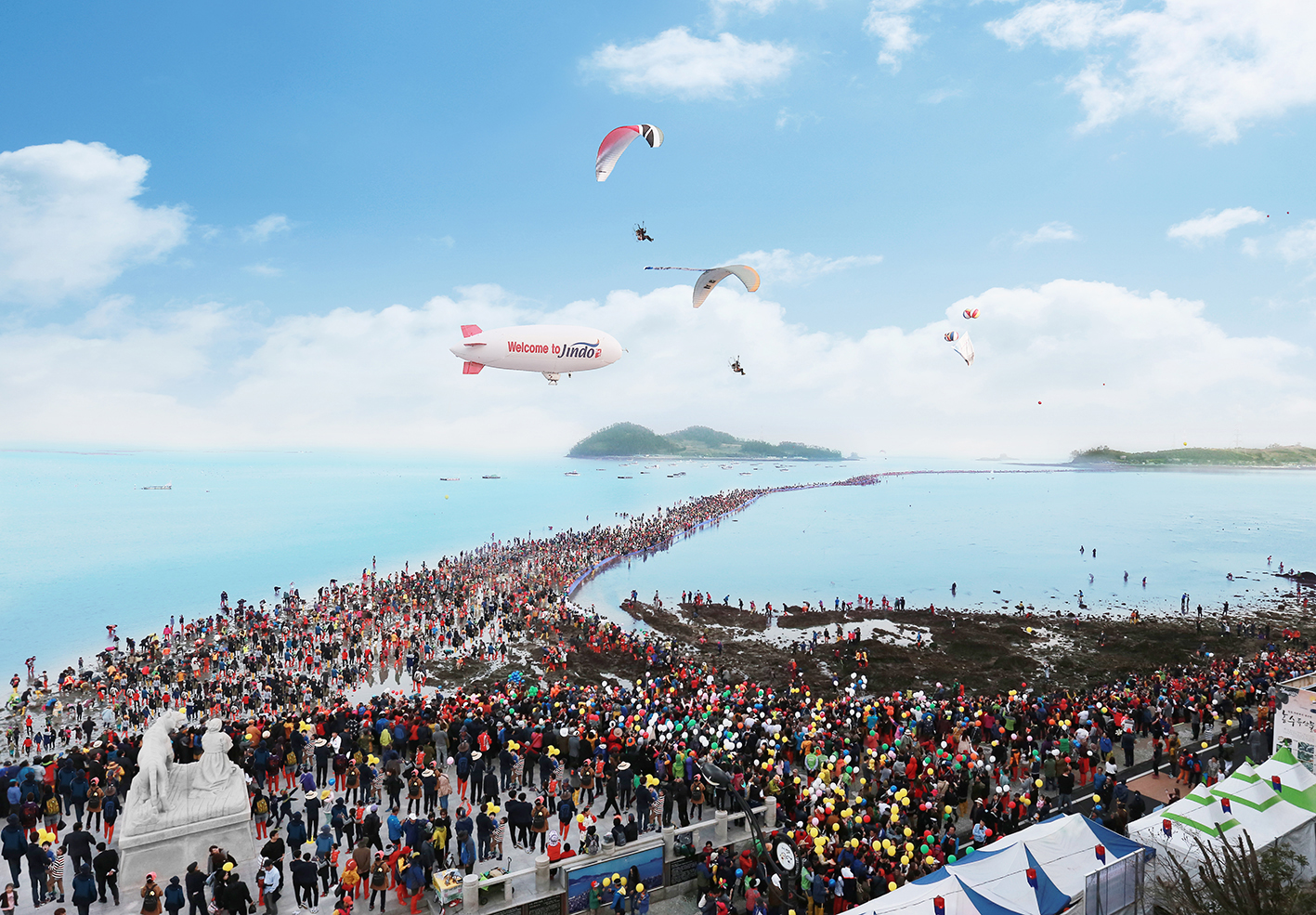The Legend of the Sea-Parting Miracle: The Story of Grandmother Ppong

Written by Mukhammadolim Alimov
Photographed by Mukhamaadolin Alimov and courtesy of Jindo County
“In 1480, near the beginning of the Joseon Dynasty, Son Dong-ji was condemned to exile on Jeju Island. During his voyage to the island, the ship was wrecked in a storm, and Son drifted ashore at a place named Hoedong, or ‘Tiger Place,” because of the many tigers in the area. Son and his descendants lived in Hoedong for over 200 years. Life was hard and villagers were frequently attacked and killed by the tigers. Finally, Son’s descendants took a raft and moved to the nearby island of Modo. However, an elderly woman named Grandmother Ppong was accidently left behind. The old lady longed to be reunited with her family and prayed for help night and day to the Dragon King of the Sea. Then one night early in March, the Dragon King appeared to her in a dream and told her to cross the sea by walking on the rainbow that he would provide for her. When she awoke, she ran to the sea and once again prayed to the Dragon King. Immediately, a rainbow-shaped opening appeared in the water between Hoedong and Modo. Grandmother Ppong started out over the rainbow path, but the exertion was too much for her, and she collapsed. Her family, crossing the rainbow from the other side, found her, and as she died in their arms, she said ‘I am happy because the Dragon King has reunited me with my family.’ The inhabitants of Jindo Island still perform an annual ritual in remembrance of the sea-parting miracle and grandmother Ppong, and many people come here to pray for their children and the people they love, so that their wishes come true.”
This Legend of Grandmother Ppong is written on a stone in three languages (Korean, English, and Chinese) near the shore where the annual sea-parting takes place. The Jindo islanders have made rituals from the story into a big, interesting, cultural festival. As a result, a substantial number of tourists and international people who reside in Korea visit Jindo each year to take part in this festival.

This year, the event took place on April 29. The number of visitors was in the thousands. To make the day full of joy, the organizers of the festival arranged many interesting shows. While walking along the seashore, you could hear traditional Korean folk music like “Arirang.” At the entrance of the festival was a local open theater where artists demonstrated and performed in shows related to topics about Korean folk culture. Korean traditional and modern dancing are examples of the kinds of shows I observed. And when trained dogs performed several tricks, the mood of the whole audience became lighter. The trainers of the dogs were very skilled, so they had taught the dogs to do many difficult routines. One of the dogs could even count by barking, and this surprised many of the visitors. At the center of the event grounds was a circle, and it was surrounded by various food tents of different nationalities such as Korean, Japanese, Chinese, Turkish, German, and Vietnamese. So, everyone could enjoy different tastes in a small space. Also at the center, there was a square with sand where wrestling matches were held. Many wrestlers fought with each other, making the day more enjoyable. There were some girl wrestlers who competed against boy wrestlers and won their matches. Although wrestling between two different genders is against the sport’s rules, their performance entertained the audience, and female visitors loudly applauded when a girl wrestler won.
The festival gives people enjoyment, and additionally, contributes to Jindo’s economic growth. For example, upon entering the festival area, visitors must pay a fee. But it is very cheap. And there are a lot of local merchants selling sea-boots and food. It gives a remarkable chance for local people to earn money. This is a good deed that the administration of Jindo Island provides for its inhabitants.
The administration cares about the safety of visitors. During the festival, you could see many police officers and military personnel since the festival was near the sea. They also led the participants across the sea because the crossing on foot wasn’t an easy task. And one couldn’t be 100 percent safe. To avoid any unpleasant situations, there were organized rescue boats at the ready. But no one really noticed that they were rescue boats because there was a ship parade in the middle of the day. The ship parade demonstrated some interesting rituals with music, and they poured blue and red coloring into the water representing the flag of Korea.
There was also a color dancing game. The participants bought white T-shirts with the game’s name on them. They then colored each other’s T-shirt with powdered colors. This dancing activity was similar to a festival that usually takes place in India, the famous “Holi Holiday.” It was a lot of fun.
The actual sea-crossing took place after 6 p.m. because the level of the seawater was three meters high during the daytime, so it was impossible to cross. We knew that at night the tide was out and that the sea would leave “gifts” for everyone, oysters, for example. The line of “sea-crossers” was a few hundred meters in length.
The main sea-crossers of the event consisted of people who came to Korea from English-speaking countries to teach English and others who came to study in Korea.
Events such as this amaze international residents, for how can Koreans create such big events from such little legends? This little annual ritual has now become a huge event.
The Author
Mukhammadolim Alimov is from Uzbekistan. He is 25 years old and a second-year student of Chonnam National University. He likes playing tennis and chess, and swimming.





